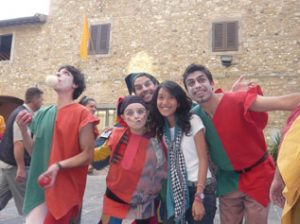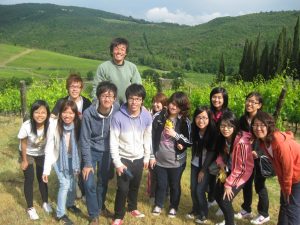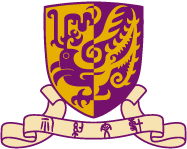目的地
意大利 ( 意大利)Venice, Florence and the Chianti region (Italy)
Italy is a peninsula extending from Southern Europe into the Mediterranean Sea, with adjacent islands, principally Sicily and Sardinia. Italy has shared borders with France in the north-west, Switzerland and Austria in the north and Slovenia in the north-east. It is divided into 18 regions. Italian is the language of the majority of the population. However, there are minorities speaking German, French, Slovene and Ladino.
Italy has a long history of civilization since 8th century BC. After the Middle Ages, Renaissance transform Italy into an nation of early modern art. Paintings, sculptures and architectures serve as precious resources of Italy which attract millions of tourists nowadays.
Italy is now an industrialized city in Europe. The more industrialized north contains most of the larger cities and about two-thirds of Italy’s population. The primarily agricultural south has a smaller population base. In this trip, we will visit the cities of Venice and Florence in the north first. Finally, we will travel southwards to the Chianti region, a region of wine-brewing..
Venice
Venice is the most beautiful city in the world. It is built on one hundred and seventeen small islands, and holds one hundred and fifty canals, connected by an amazing four hundred and nine bridges, of which only three cross the main canal. The area it covers is a mere 284 miles (458 kilometres). Although the city appears small, it is really quite extensive for its size.
Florence
Florence is one of the most beautiful cities in the world. It is the cultural capital of Italy and one the cultural capitals of Europe. The changes that we associate with the Renaissance first occurred in the city of Florence and continued to be more pervasive there than anywhere else. The city’s economy and its writers, painters, architects, and philosophers all made Florence a model of Renaissance culture.
The Chianti region
The Chianti region is located at the south of Venice and Florence. It is in the territories of Tuscany. The panorama of oak, pine, olive groves, vineyards and cypresses, its steep hills and the red-tiled roofs of the farm houses make it instantly recognisable. Culture, history and tradition together with its famous wine and cookery, make the Chianti zone of Tuscany a wonderful vacation destination.
Source:
Ammonet Infotech (2010). Chianti. Retrieved August 4, 2010 from http://www.chianti-chianti.net/
Italian Government Tourist Board (2010). ITALIA Planning Your Trip – General Info. Retrieved August 4, 2010 from, Web site: http://www.italiantourism.com/geninfo.html
行程安排
In the summer of 2009, a field trip to Venice, Florence and the Chianti region of Italy was organized by the Department of Geography and Resource Management. This was the first time for the Department to organize a trip to Europe. The study group consists of 31 undergraduate students, together with Prof. Claudio Delang, as the trip leader, and Mr. Wong Wai Fung as the trip tutor. The trip lasted for 13 days in total, starting from 21 May to 2 June 2009.
Objectives
Our Department’s field trips let students broaden their horizon and knowledge base through interaction with overseas students and scholars with different disciplines. It enables students to make comparative studies between Hong Kong and other countries/regions. It also provides a platform for students to plan their own study and develop their own research skills.
Study mode
Before the trip, 31 students were divided into 6 groups. Each group was assigned a topic concerning the studies either in Venice or the Chianti region. Students were required to gather information, read relevant articles related to the corresponding topic and present their study plan.
During the trip in Venice and the Chianti region, the topics were examined further by guided tours, visits and lectures. Each group was responsible to lead the group discussion at nights and all the study groups were invited to share what they have learnt.
During the trip in Florence, 31 students are divided into another 4 groups. Each group formulated their own topics. Students were required to gather information in the field through observation or interviews. They would organize the gathered information and make a presentation.
Assessment
This field trip allowed students to fulfill a compulsory course requirement for all major students. Assessments for the students were based on their participation and presentation before as well as during the trip. Students were required to submit a detailed report after the trip.
DAY 1
21/05/2009
DAY 2
22/05/2009
DAY 3
23/05/2009
DAY 4
24/05/2009
DAY 5
25/05/2009
DAY 6
26/05/2009
DAY 7
27/05/1009
DAY 8
28/05/2009
DAY 9
29/05/2009
Visit the area by local authority in Tavarnelle on the topic of rural heritage conservation
DAY 10
30/05/2009
DAY 11
31/05/2009
DAY 12
01/06/2009
Student Sharing
Presentations of Students
Presentations on the issues of Venice and the Chianti region
Group 2 : Naturalistic aspects of the lagoon of Venice
Group 3 : Murano and Burano: how to maintain the thunder?
Group 4 : Contemporary management of Venice: the VEGA and the industrial estate, the port
Group 5 : Sea level rise in a low-lying (sinking) island: Venice’s problems and its solution, the Mose (Modulo Sperimentale Elettromeccanico)
Group 6 : The Chianti region: rural development, people-environment relationship & wine production
Presentations on the issues of Florence
Group B : Tourism Management in Florence Connectivity between Major Tourist Attractions
Group C : SWOT analysis of tourism in Florence
Group D : To what extent does the tourism industry affect the relocation of major land use
Comments and Afterthoughts of the Students
Cheung Ka Ling
Kwok Chung Kit, Kanic
Li Wing Man
Wong Wai Fung
Presentations of Students
Our objectives are broadening our students’ horizon and knowledge base and letting them plan their own study and develop their own research skills. In order to achieve the above objectives, students are divided into groups to gather information and make presentation.
Before the trip, information is gathered from the websites and books. Each group will present their introduction of topics and their study plan.
During the trip, topics of diverse aspects were assigned to each group. Students are required to interact with local people, such as interviews, attending lectures and joining guided tours in the daytimes, primary information is obtained. Students are required to present their findings in the evening presentation sessions.

Self-paced studies: interactions with local students in Siena
Presentations on the issues of Venice and the Chianti region
Date: 19 May 2009
Place: Hong Kong
Group presentation files are as follows:
Group 1 : Sustainability, challenges & opportunities of tourism in Venice
Group 2 : Naturalistic aspects of the lagoon of Venice
Group 3 : Murano and Burano: how to maintain the thunder?
Group 4 : Contemporary management of Venice: the VEGA and the industrial estate, the port
Group 5 : Sea level rise in a low-lying (sinking) island: Venice’s problems and its solution, the Mose (Modulo Sperimentale Elettromeccanico)
Group 6 : The Chianti region: rural development, people-environment relationship & wine production
Presentations on the issues of Florence
Date: 28 May 2009
Place: Florence
Group presentation files are as follows:
Group A : Relationship between cultural heritage and human
Group B : Tourism Management in Florence Connectivity between Major Tourist Attractions
Group C : SWOT analysis of tourism in Florence
Group D : To what extent does the tourism industry affect the relocation of major land use
Comments and Afterthoughts of the Students
- Cheung Ka Ling
- Kwok Chung Kit, Kanic
- Li Wing Man
- Wong Wai Fung
Cheung Ka Ling
Italy is the dream place of many people and for my first time to go aboard, the destination was Italy, how lucky I was! In the last summer, I had joined the field trips organized by the department ahead to Italy and it had become one of the unforgettable memories in my life.
The beautiful scenes definitely moved my heart. We had been to many places in Venice, Florence and Chianti and there were many uncountable beautiful places like San Marco Square, the Medici Chapels, Piazza della Repubblica, Duomo, Piazza del Campo and the widespread wine field, we were all astonished at the greatness of the foreign architectures. We had met many wonderful people and the adventures in the medieval festival in a castle also let us experience the different cultures and as a perfect ending of our journey.
The 9 days seemed to be too short! It is a precious and impressed experience to be with all the Grmers and here want to thank you to our beloved professor and tutors who took care of all of us for so many days and giving us such a precious opportunity!
Cheung Ka Ling (photo: left)
Kwok Chung Kit, Kanic
Italy, a place where the Renaissance started, still maintains her characteristics of the internationally influential movement nowadays. We had visited three parts of the country – Venice, Florence, and the Chianti region. As a local student from Hong Kong, who has not travelled outside the Asia region, it was a really great opportunity to take a look to the world that has been recorded in our history textbook.
In Italy, we can find the sinking city in Venice with several canals. Gondola, used to be a major transportation in the past, has been one of the tourist attractions there. St. Mark Square, with thousands of pigeons, also is an ideal place to hang around. In Florence, we have visited lots of historical heritages and also Marble sculpture as well. We had a really great time in Florence and knew more about the geographical issues related to the city through group projects. Then, we got to Chianti region. Unlike the cities we visited before, it is not really a city, but country. It is a rural area that most of the lands are covered by grapevines and olive trees. I have never seen a place like that before.
This was my first oversea field trip and it was a really wonderful trip which I can know more about the culture and geographic related topics about European cities. I would like to thank Professor Claudio Delang and Tutor Vincent to prepare for the field trip. We did enjoy and learn a lot during the field trip!
Kwok Chung Kit, Kanic (photo: left)
Li Wing Man
The picture below is an olive tree plantation which I can also hardly see in Hong Kong. Together with the beautiful blue sky, it really makes a stunning view. This view is breath taking. It gives me a feeling of peace and harmony. Unlike Hong Kong, here are no tall buildings or overcrowded streets, just a large piece of green which makes me feel relieved and relaxed.

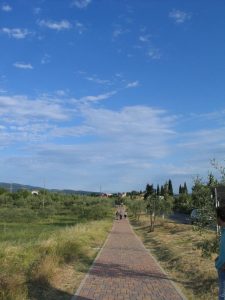
I like the environment here very much. A little pavement with trees on both sides makes walking a very pleasant thing.
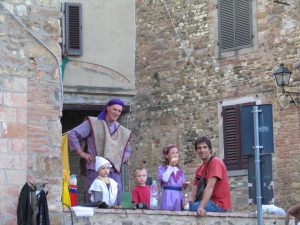
People here are really friendly. They would say ‘ciao’ to you with a smile even you are a stranger. I really enjoy this trip because of not only academic knowledge gained, but also cultural experience attained!
Li Wing Man
Wong Wai Fung

